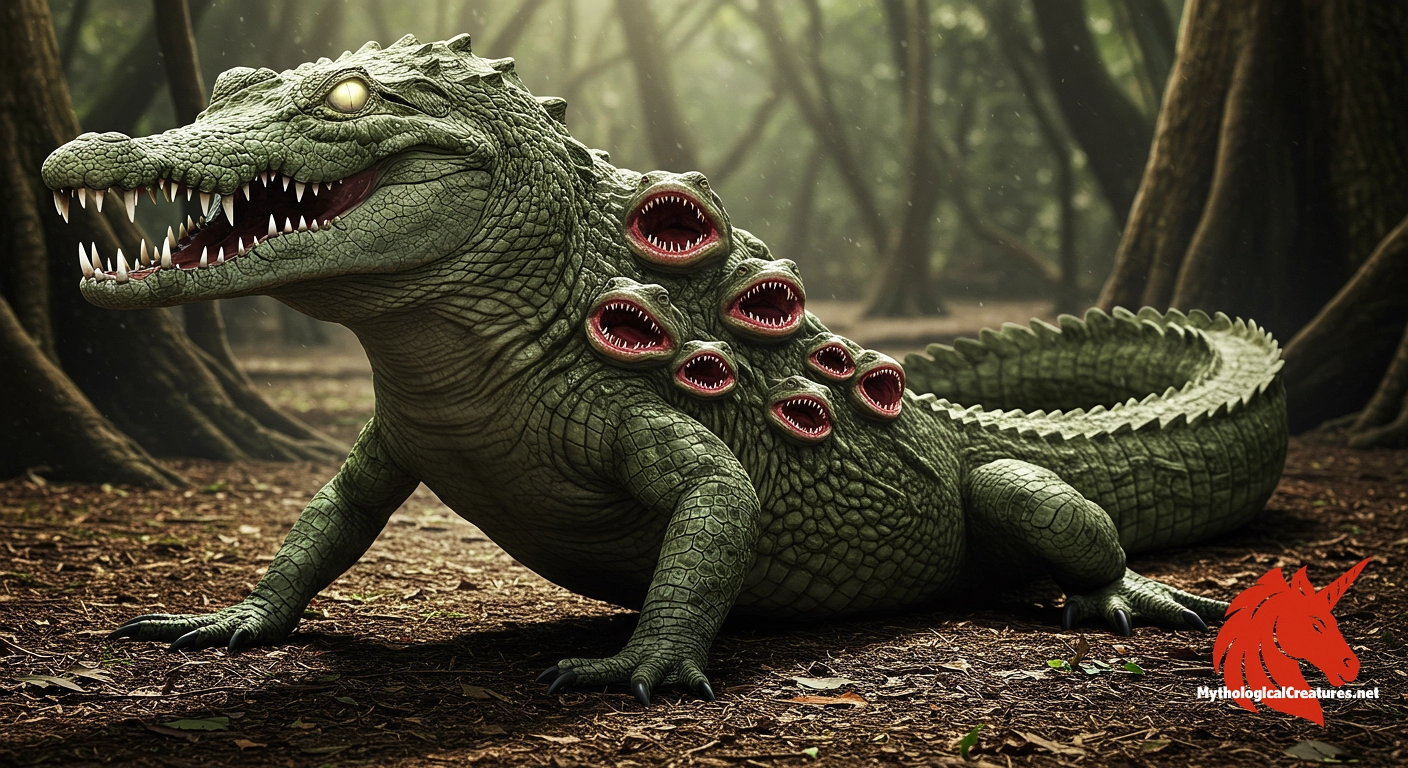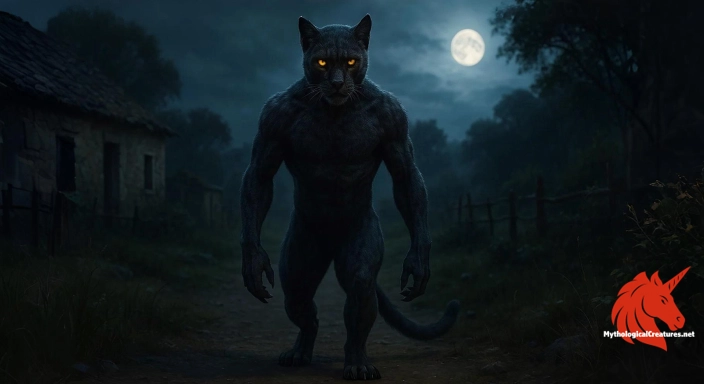Cipactli: Cipactli is a primeval, monstrous sea creature from Aztec mythology, known for its composite body and extra mouths at every joint.

Cipactli
Cipactli - Represents the primordial chaos from which the ordered world was created, embodying both destructive and creative forces.
Origins & First Encounters
Cipactli emerges from the primordial mists of Aztec mythology as a fearsome sea monster whose very form defies conventional categorisation. It is depicted as a chimerical creature, combining the traits of a crocodile, fish, and toad in a singular, awe‐inspiring manifestation. This enigmatic being is not only emblematic of the chaotic forces of nature but also stands central to the myth of earth’s creation. Ancient narratives recount that from the body of Cipactli, the gods fashioned the terrestrial world, imbuing the creature with dual roles of destruction and creation. Its indefinite gender and insatiable hunger, symbolised by the extra mouths on every joint, further enhance its mystique. Cipactli’s formidable presence is interwoven with the exploits of powerful deities, notably Tezcatlipoca and Quetzalcoatl. The myth encapsulates the Mesoamerican belief in a living cosmos, where primordial chaos gives rise to order through divine intervention. And beneath the layers of myth, Cipactli represents the unpredictable forces that govern both nature and creation.
Source Texts & Tale Variants
The legends surrounding Cipactli have been preserved through a variety of ancient codices, bas-reliefs, and oral traditions that span several Mesoamerican cultures. Early Aztec sources portray the monster as a pivotal figure in the cosmogonic pantheon, where its dismemberment forms the bedrock of the earth. In parallel, the Maya tradition acknowledges Cipactli through the tzolk’in, linking the creature to the day known as Imix. Various mythological texts also hint at linguistic connections, exemplified by the resemblance between Cipactli and the name Sipakna in Mayan narratives. Meanwhile, Olmec sculptures and bas-reliefs have captured its crocodilian aspects, especially in depictions where the creature appears to exhale rain clouds. These visual and textual records are rich with symbolism, providing insights into the role and nature of Cipactli within different local traditions. Oral accounts from diverse indigenous communities further complement the preserved codices, adding layers to its story. Over time, alternative versions emerged that portray the creature as Tlaltecuhtli, or the earth monster, thus broadening its mythological significance. All of these sources, layered with interpretations and adaptations, contribute to a multifaceted understanding of Cipactli’s role in Mesoamerican cosmogony. This diversity in storytelling underscores the creature’s enduring impact across generations and regions.
Form & Powers
Cipactli is portrayed as an immense and composite entity whose physical attributes merge multiple animal forms into one bewildering shape. Its body bears the rugged, scaled texture typical of a crocodile, yet intermingles with the sleek, sinuous qualities of a fish. In some depictions, the creature exhibits the rotund, amphibious characteristics of a toad, further accentuating its hybrid nature. Each of its many joints is adorned with an extra mouth, a detail that symbolises an unquenchable appetite and the ongoing cycle of creation and destruction. The anatomical features of Cipactli defy normal biological classification, blurring the lines between land and water, beast and deity. Its form is both formidable and fluid, often rendered as a vast, writhing mass that hints at the chaotic energy from which the world originated. The arrangement of multiple heads and mouths across its body not only signifies voracious hunger but also suggests an inherent power that is distributed throughout its entire being. Variations in its depiction, from colossal to more modest dimensions, reflect the creature’s adaptive symbolism in local retellings. The convergence of reptilian, piscine, and amphibian traits in its design offers a visual narrative of nature’s complexity and the enigmatic forces that drive cosmic creation. Ultimately, the physicality of Cipactli is both a literal and metaphorical blueprint for the emergence of order from formless chaos.
Regional Faces
The myth of Cipactli is a tapestry woven with diverse threads from different regions of Mesoamerica, each contributing its unique nuances to the creature’s identity. In the heartland of the Aztecs, Cipactli is remembered as the insatiable beast whose very anatomy played a crucial role in the creation of the earth. Meanwhile, in Maya traditions, the creature is interlaced with calendrical symbolism, being identified with the day Imix and resonating with themes of rebirth. In the Olmec cultural sphere, similar creatures appear in art and sculpture that depict crocodilian figures exhaling rain-bearing clouds, reinforcing its association with elemental forces. Some regional variants even refer to the creature as Tlaltecuhtli, transforming it from a mere monster into an embodiment of the very earth. Indigenous communities across Mexico and Central America have passed down oral versions of the story, often localising its attributes to reflect the surrounding landscape and spiritual beliefs. The creature’s name also adapts to local tongues; for instance, in Migian folklore, Cipactli is known as Quanai. Each regional portrayal, while maintaining the core motifs of ferocity and creativity, is coloured by local symbolism and environmental influences. These variations highlight how Cipactli transcends a single narrative, instead reflecting a spectrum of cultural interpretations about nature and creation. Thus, his myth remains as fluid and adaptive as the landscapes from which it originates.
Cultural Parallels
Cipactli shares a kinship with several mythological figures from across the globe, serving as an archetype of primordial chaos whose dismemberment yields new creation. Its narrative echoes that of Tiamat in Babylonian cosmogony, where the slaying of a chaotic monster gives way to the formation of the world. Similar to the Norse giant Ymir, whose body parts become the fabric of the earth, Cipactli’s very flesh is transformed into fertile ground. The creature’s amphibious and chimeric nature finds parallels in the legendary Leviathan of biblical lore, both embodying the power and unpredictability of watery realms. The recurring motif of a monstrous chaos being whose division spawns life underscores a shared human preoccupation with the transition from primordial disorder to organised existence. Across cultures, these figures highlight nature’s dual capacity for both creation and dissolution, a theme that is central to many ancient mythologies. The multiplicity of features found in Cipactli – part reptile, part amphibian, part fish – also mirrors the composite qualities of other hybrid beings whose forms represent the convergence of distinct natural elements. This convergence of attributes is not merely a physical depiction but a symbolic expression of the intertwined forces of life, death, and rebirth. By comparing Cipactli with its counterparts worldwide, one sees a universal narrative in which chaos is both destructive and creative. Such cross-cultural parallels affirm the enduring allure of myths that celebrate transformation through disintegration and regeneration.
Legacy & Modern Evolution
The myth of Cipactli has traversed the annals of time, evolving from its ancient origins into a symbol rich with cultural and artistic significance. Once central to Aztec creation lore, the creature’s narrative was meticulously recorded in codices and monumental sculptures that celebrated its awe-inspiring power. As centuries passed, colonial narratives and subsequent historical reinterpretations added layers of complexity to its story, sometimes obscuring its original context while always retaining its symbolic potency. In modern times, Cipactli has become a muse for artists, writers, and scholars who view the creature as a metaphor for the cyclical nature of destruction and renewal. Contemporary depictions often emphasise its role as an emblem of life’s regenerative forces and the eternal dance between chaos and order. The myth continues to inspire modern Mesoamerican identity, where it is reimagined as a potent symbol of natural power and ancestral heritage. Digital media, literature, and visual arts have all embraced the image of Cipactli, recalibrating its ancient symbolism to speak to current cultural and environmental concerns. Academic discourses have also reinvigorated interest in its multifaceted portrayal, exploring themes of creation, dismemberment, and transformation. As the creature’s legacy adapts to new contexts, it persists as a testament to the timeless allure of myth and the universal quest to understand our origins. Through every retelling and reinterpretation, Cipactli endures as a dynamic symbol bridging the gap between a storied past and a continually evolving present.
Interesting Fact
Cipactli's composite anatomy and the surreal detail of extra mouths on every joint have led scholars to view it as a living metaphor for the boundless creative energy and destructive potential inherent in primordial chaos.
Quick Creature Info
Origin:
Associations:
Our Mythic Legendary Rating:

Also Sometimes Known As:
Habitat:
Supernatural Powers:
Physical Attributes:
Abilities:
Behavior:
Lore:
Related Creatures, Tales or Lore
References
Discover Another Mythical Legend You May Not Have Heard Of?
Uncover the mysteries of ancient folklore and expand your knowledge of legendary beings from cultures around the world.
Dare to Meet the Hombre Gato....
Mythical Disclaimer: The images and data on this site are derived from various historical and literary sources, but we have found that many myths often have multiple versions and interpretations across references, sometimes contradictory. As a result, these creature depictions are artistic interpretations—imaginative blends of folklore, legend, and a dash of AI guesswork. Because creature descriptions vary widely, our illustrations and accompanying information represent our best effort to honor mythology while bridging creative gaps. Enjoy these interpretations—just remember, we've done our best to respect the stories and validate available data, but in the realm of mythology, details often shift, imagination leads the way, and nothing is ever set in stone!
Curated by the Mythological Creatures Team (rev. May 2025)
